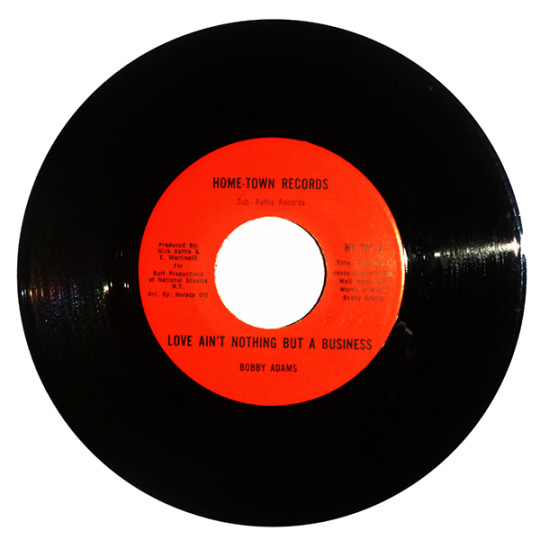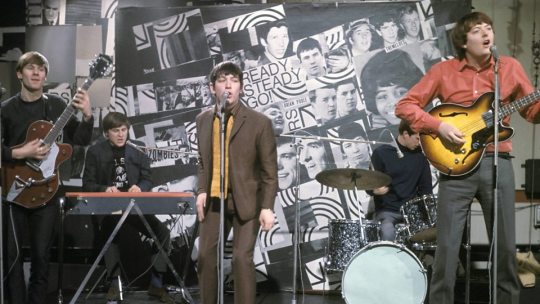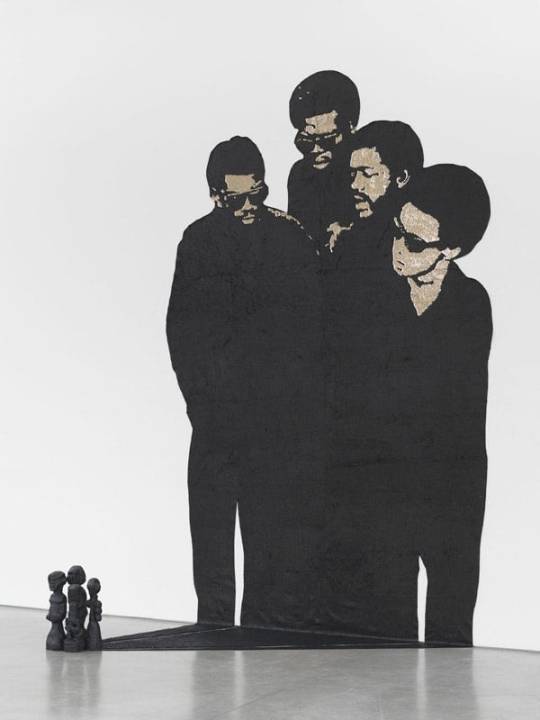#Horace Ott
Text

Bobby Adams - Love Ain't Nothing But A Business (Home-Town)
arr. Horace Ott.
Junior Parker also did a version of this tune, though this Horace Ott (one of my favourite arrangers) arrangement is fantastic and funky. Instrumental on the flip, where maybe someone could extend the piano riff with doubles. Cheapy!
#Bobby Adams#Love Ain't Nothing But A Business#love aint nothing but a business goin on#junior parker#horace ott#soul#funk#45#samples#doubles#cheap 45
16 notes
·
View notes
Video
youtube
LECTURE 12: IN THE SHADOW OF THE BEATLES: British blues rockers The Animals perform their big hit “Don’t Let Me Be Misunderstood” on The Ed Sullivan Show, a song originally performed by singer, songwriter, musician and civil rights activist Nina Simone (1933-2003), and written by Bennie Benjamin, Horace Ott and Sol Marcus. The Animals’ version of the song soared into the Top 10 in Great Britain, France, Sweden, Ireland and Canada, and the Top 20 in the United States, in early 1965. (It would later be remade in 1977 by disco group Santa Esmeralda.)
#The Animals#Eric Burdon#British Invasion#1965#Blues#Blues Rock#Don't Let Me Be Misunderstood#Nina Simone#Bennie Benjamin#Horace Ott#Sol Marcus#Santa Esmeralda
0 notes
Text
♫ Please Don't Let Me Be Misunderstood ♫ (Redux)
My favourite Animals’ song is “House of the Rising Sun”, but this one runs a close second. Overall I am not an Animals’ fan, but they did have several that made it to my playlist, and this is one of them.
This song was written by Horace Ott, Bennie Benjamin and Sol Marcus. Benjamin and Marcus were a songwriting team that had been working together since the ’40s; their compositions include…

View On WordPress
1 note
·
View note
Photo

AllMusic Staff Pick:
Jimmy McGriff
Electric Funk
While not a textbook definition of Funk, these tunes still radiate a slow jam funkiness, with brassy horns, skittering drum fills, and Jimmy McGriff's signature organ humming along on the verses and Horace Ott's electric piano singing the choruses. Highlights include the Bernard Purdie drum clinic "The Bird Wave" and the closing stomper "Funky Junk."
- Zac Johnson
4 notes
·
View notes
Text
THE BEAST WITHIN (1982) – Episode 249 – Decades Of Horror 1980s
“Oral sodomy?… Well, that’s why it’s a small town… Yeah, we’ll look into it. Thank you for calling.” Say what? Join your faithful Grue Crew – Chad Hunt, Bill Mulligan, Crystal Cleveland, and Jeff Mohr – as they confront the over-the-top effects, excellent acting, and confusing story in The Beast Within (1982).
Decades of Horror 1980s
Episode 249 – The Beast Within (1982)
Join the Crew on the Gruesome Magazine YouTube channel!
Subscribe today! Click the alert to get notified of new content!
https://youtube.com/gruesomemagazine
Decades of Horror 1980s is partnering with the WICKED HORROR TV CHANNEL (https://wickedhorrortv.com/) which now includes video episodes of 1980s and is available on Roku, AppleTV, Amazon FireTV, AndroidTV, and its online website across all OTT platforms, as well as mobile, tablet, and desktop.
A young woman gets raped by a mysterious man-creature, and years later her son begins a horrific transformation into a similar beast.
Directed by: Philippe Mora
Writing Credits: Tom Holland (screen story and screenplay by); Edward Levy (novel by)
Produced by: Harvey Bernhard, Gabriel Katzka
Music by: Les Baxter
Cinematography by: Jack L. Richards (director of photography)
Special Makeup Effects: Thomas R. Burman (created and designed by)
Selected Cast:
Ronny Cox as Eli MacCleary
Bibi Besch as Caroline MacCleary
Paul Clemens as Michael MacCleary
Don Gordon as Judge Curwin
R.G. Armstrong as Doc Schoonmaker
Katherine Moffat as Amanda Platt (as Kitty Moffat)
L.Q. Jones as Sheriff Pool
Logan Ramsey as Edwin Curwin
John Dennis Johnston as Horace Platt
Ron Soble as Tom Laws
Luke Askew as Dexter Ward
Meshach Taylor as Deputy Herbert
Boyce Holleman as Doc Odom
Natalie Nolan Howard as Court Clerk
Malcolm McMillin as Gas Station Attendant
Fred D. Meyer as Workman
In the early 1980s, producer Harvey (The Goonies, The Lost Boys) Bernhard purchases an unfinished novel by Edward Levy and hires Tom (Fright Night, Child’s Play) Holland – his first feature film credit – to write the screenplay (from scratch). He follows this up by scooping up Philippe Mora, the talent behind Communion and The Howling II: Your Sister is a Werewolf (cue blank stare), to direct. The result is the often maligned creature feature The Beast Within (1982) featuring Paul Clemens, Ronny Cox, Bibi Besch, Don Gordon, R. G. Armstrong, Katherine Moffat, L. Q. Jones, Logan Ramsey, Luke Askeew, John Dennis Johnston, Meschach Taylor, and Ron Soble. While the make-up effects by Thomas R. Burman (Prophecy, Altered States) are collectively praised, the premise received far more disparagingly negative critiques. Now it is time for the Grue Crew to settle the score. Is it a schlocky disaster or a grotesque cult-classic?
At the time of this writing, The Beast Within is available for streaming from Tubi and as PPV from Amazon and AppleTV. The film is available on physical media in Blu-ray format from SHOUT! Factory.
Every two weeks, Gruesome Magazine’s Decades of Horror 1980s podcast will cover another horror film from the 1980s. The next episode’s film, chosen by Grue Crew for their sestercentennial episode (that’s 250th, Grue Belivers), will be Gremlins (1984), with guest host Ralph Miller who is one of the effects artists who worked on the film as part of Chris Walas’ crew. This should be fun!
Please let them know how they’re doing! They want to hear from you – the coolest, grooviest fans – so leave them a message or comment on the Gruesome Magazine Youtube channel, on the Gruesome Magazine website, or email the Decades of Horror 1980s podcast hosts at [email protected].
Check out this episode!
0 notes
Text
I honor my triggers,
Because they reveal where I need to focus
How beautiful it is to be alive and experiencing
Currently Listening 🎷🎧 Our Love (Will See Us Through) - Nina Simone & Horace Ott
0 notes
Text
Village People “Happiest Time Of The Year” for your Holiday

Village People is one of the most iconic music groups in the world. Their music has become part of the international songbook. The group’s hits are featured in dozens of major motion pictures, on Broadway, in commercials and in “Village People Party” slot machines. Of course, Y.M.C.A (along with its dance) is played at almost every party, wedding, bar mitzvah, and sporting event in the universe.
It began in 1977 when producer Jacques Morali and his partner Henri Belolo, known collectively as Can’t Stop Productions, were recording a new album for their hit group the Ritchie Family, called African Queen and needed background singers. Horace Ott, the arranger/conductor who was working with them, suggested Victor Willis, a singer he was recording who also was performing in the Broadway musical The Wiz. After Willis completed background on the album, Morali approached him about another musical project he and Belolo were planning which turned out to be Village People.
“I had a dream that you sang lead vocals on an album I produced, and it went very, very big,” Morali told Willis. “I have four tracks. I can’t pay you much right now but if you agree, I’ll make you a star.” Willis agreed and the rest is history.
Those initial four tracks, San Francisco (You’ve Got Me), In Hollywood (Everyone’s a Star), Fire Island, and Village People were recorded by Willis with professional background singers and released as the debut album Village People in 1977. The album quickly climbed to the top of the dance charts and became an international hit.
Demand for the “Village People” to appear in concert and on television shows like American Bandstand and Merv Griffin was great. The only problem… “Village People” was Victor Willis! So Morali, Belolo and Willis had to put together an actual group… and quick. Morali and Belolo had already met Felipe Rose who dressed as a Native American. They recruited him. Willis brought in Alex Briley, who he’d previously worked with in a musical.
The quickly assembled original lineup appeared with Victor on American Bandstand was Mark Mussler (Construction Worker), David Forrest (Cowboy), Lee Mouton (Leatherman) and Peter Whitehead (nondescript). After that appearance, an ad was placed in a trade paper for ‘permanent’ members which read: Macho Types Wanted for World-Famous Disco Group — Must Dance and Have a Moustache. Randy Jones, Glenn Hughes and David Hodo answered the call.
Casablanca Records and Filmworks, the group’s label, got behind their second album Macho Man with full promotion and marketing. Village People became an international phenomenon and quickly followed with their third album, the double-platinum Cruisin (which featured the blockbuster Y.M.C.A.). They embarked on a worldwide tour in 1979 to coincide with the release of their fourth album, Go West. The group has received many honors and awards, including the American Music Award for Favorite Musical Group, a star on the Hollywood Walk of Fame, and was featured on the cover of Rolling Stone.
After Willis exited in late 1979, several singers took over as lead singer of the group, including Ray Stephens, Miles Jaye and Raymond Simpson (who served the longest). The group went on to star in the 1980 movie Can’t Stop the Music. Over the years, various renditions of the group have consistently toured the world along with original members Felipe Rose and Alex Briley including Ray Simpson, Jeff Olson (cowboy), Eric Anzalone (Biker), Mark Lee (Construction Worker), Bill Whitefield (Construction Worker), and James Newman (Cowboy).
With hits like San Francisco/In Hollywood, Macho Man, Y.M.C.A., In the Navy and Go West, the group has sold more than 100 million records worldwide and continues to break records. In 2004 BMI recognized Y.M.C.A. as exceeding one million airplays. In 2017, Y.M.C.A. made UK’s Official Millionaires Chart – songs that have reached 1 million in combined sales/streams.
For the 40th anniversary of the group, Victor Willis is back at the helm. Backed by a live band, Village People continues to thrill concert-goers around the world — as they did back in the day.
Village People is: Victor Willis (Cop/Admiral), Angel Morales (Native American), James Kwong (Construction Worker), Chad Freeman (Cowboy), James Lee (G.I.), and James J.J. Lippold (Leatherman).
Village People. The greatest disco group in the world. Magical Christmas is their first full length Christmas album. Now available.
Additional Artist/Song Information:
Artist Name: Village People
Song Title: Happiest Time Of The Year
Publishing: Ceres Music Group
Publishing Affiliation: BMI
Publishing Affiliation 2: BMI
Album Title: Magical Christmas
Record Label: Ceres Music Group
Radio Promotion:
Loggins Promotion
Paul Loggins
310-325-2800
Contact Loggins Promotion
Publicity/PR:
Loggins Promotion
Paul Loggins
310-325-2800
Contact Loggins Promotion
Read the full article
0 notes
Text
Village People “Happiest Time Of The Year” for your Holiday play: Radio/Media Download Here

Village People is one of the most iconic music groups in the world. Their music has become part of the international songbook. The group’s hits are featured in dozens of major motion pictures, on Broadway, in commercials and in “Village People Party” slot machines. Of course, Y.M.C.A (along with its dance) is played at almost every party, wedding, bar mitzvah, and sporting event in the universe.
It began in 1977 when producer Jacques Morali and his partner Henri Belolo, known collectively as Can’t Stop Productions, were recording a new album for their hit group the Ritchie Family, called African Queen and needed background singers. Horace Ott, the arranger/conductor who was working with them, suggested Victor Willis, a singer he was recording who also was performing in the Broadway musical The Wiz. After Willis completed background on the album, Morali approached him about another musical project he and Belolo were planning which turned out to be Village People.
“I had a dream that you sang lead vocals on an album I produced, and it went very, very big,” Morali told Willis. “I have four tracks. I can’t pay you much right now but if you agree, I’ll make you a star.” Willis agreed and the rest is history.
Those initial four tracks, San Francisco (You’ve Got Me), In Hollywood (Everyone’s a Star), Fire Island, and Village People were recorded by Willis with professional background singers and released as the debut album Village People in 1977.
Read the full article
0 notes
Text
Village People “Happiest Time Of The Year” for your Holiday play: Radio/Media Download Here

Village People is one of the most iconic music groups in the world. Their music has become part of the international songbook. The group’s hits are featured in dozens of major motion pictures, on Broadway, in commercials and in “Village People Party” slot machines. Of course, Y.M.C.A (along with its dance) is played at almost every party, wedding, bar mitzvah, and sporting event in the universe.
It began in 1977 when producer Jacques Morali and his partner Henri Belolo, known collectively as Can’t Stop Productions, were recording a new album for their hit group the Ritchie Family, called African Queen and needed background singers. Horace Ott, the arranger/conductor who was working with them, suggested Victor Willis, a singer he was recording who also was performing in the Broadway musical The Wiz. After Willis completed background on the album, Morali approached him about another musical project he and Belolo were planning which turned out to be Village People.
“I had a dream that you sang lead vocals on an album I produced, and it went very, very big,” Morali told Willis. “I have four tracks. I can’t pay you much right now but if you agree, I’ll make you a star.” Willis agreed and the rest is history.
Those initial four tracks, San Francisco (You’ve Got Me), In Hollywood (Everyone’s a Star), Fire Island, and Village People were recorded by Willis with professional background singers and released as the debut album Village People in 1977.
Read the full article
0 notes
Text
Village People "Happiest Time Of The Year"

Village People is one of the most iconic music groups in the world. Their music has become part of the international songbook. The group's hits are featured in dozens of major motion pictures, on Broadway, in commercials and in "Village People Party" slot machines. Of course, Y.M.C.A (along with its dance) is played at almost every party, wedding, bar mitzvah, and sporting event in the universe.
It began in 1977 when producer Jacques Morali and his partner Henri Belolo, known collectively as Can't Stop Productions, were recording a new album for their hit group the Ritchie Family, called African Queen and needed background singers. Horace Ott, the arranger/conductor who was working with them, suggested Victor Willis, a singer he was recording who also was performing in the Broadway musical The Wiz. After Willis completed background on the album, Morali approached him about another musical project he and Belolo were planning which turned out to be Village People.
"I had a dream that you sang lead vocals on an album I produced, and it went very, very big," Morali told Willis. "I have four tracks. I can't pay you much right now but if you agree, I'll make you a star." Willis agreed and the rest is history.
Those initial four tracks, San Francisco (You've Got Me), In Hollywood (Everyone's a Star), Fire Island, and Village People were recorded by Willis with professional background singers and released as the debut album Village People in 1977.
Read the full article
0 notes
Text
Village People "Happiest Time Of The Year" for your Holiday play: Radio/Media Download Here

Village People is one of the most iconic music groups in the world. Their music has become part of the international songbook. The group's hits are featured in dozens of major motion pictures, on Broadway, in commercials and in "Village People Party" slot machines. Of course, Y.M.C.A (along with its dance) is played at almost every party, wedding, bar mitzvah, and sporting event in the universe.
It began in 1977 when producer Jacques Morali and his partner Henri Belolo, known collectively as Can't Stop Productions, were recording a new album for their hit group the Ritchie Family, called African Queen and needed background singers. Horace Ott, the arranger/conductor who was working with them, suggested Victor Willis, a singer he was recording who also was performing in the Broadway musical The Wiz. After Willis completed background on the album, Morali approached him about another musical project he and Belolo were planning which turned out to be Village People.
"I had a dream that you sang lead vocals on an album I produced, and it went very, very big," Morali told Willis. "I have four tracks. I can't pay you much right now but if you agree, I'll make you a star." Willis agreed and the rest is history.
Those initial four tracks, San Francisco (You've Got Me), In Hollywood (Everyone's a Star), Fire Island, and Village People were recorded by Willis with professional background singers and released as the debut album Village People in 1977.
Read the full article
0 notes
Text
al things considered — when i post my masterpiece #768

first posted in facebook november 14, 2019
sanford biggers -- "overstood" (2017)
"harriet tubman was an astronaut, traversing the south to the north by navigating the stars" ... biggers sanford
"baby, you understand me now
if sometimes you see that i'm mad
don't you know no one alive can always be an angel?
when everything goes wrong, you see some bad" ... bennie benjamin & sol marcus
"'overstood' ... puts biggers’s artful wordplay on display. highlighting the subtle political orientation of the verb 'to understand,' one might begin to wonder if the term, as a spatial metaphor, implies (or perhaps even demands) that the comprehension of an idea requires a kind of ideological submission" ... steven pestana
"four small black figures are positioned a foot or so away from the wall. stretching from the figures, up and onto the wall, are long shadows rendered in black sequins, culminating in four faces, which biggers drew with his fingers, flaking over the sequins and exposing their gold undersides. he found the faces while searching through images on google, which is something of a pastime for him. the source photograph is of the black panther chairman bobby seale and a man named george murray, who, when the picture was taken, had just been fired from the faculty of san francisco state university, after joining the panthers and advocating that black students take up arms against racist violence" ... vinson cunningham
"but i'm just a soul whose intentions are good
oh lord, please don't let me be misunderstood" ... horace ott
"biggers called his show 'selah,' after the ancient hebrew word that appears as a kind of poetic interjection throughout the psalms, and which is thought to have been a musical notation designating a rest. in the churches i grew up in, a preacher or a teacher would deliver the crux of the lesson, the part designed to reach past narrative and deliver a prick to the listener’s heart, and then, softly, say 'selah,' as if to insist: think about that for a second, before we move on. the word, applied to biggers’s work, might act as an acknowledgment of a stubborn but essential quietness, engineered to demand a pause from the viewer" ... vinson cunningham
"but i'm just a soul whose intentions are good
oh lord, please don't let me be misoverstood ...
selah" ... al janik
#sanford biggers#overstood#harriet tubman#astronaut#navigating the stars#bennie benjamin#sol marcus#steven pestana#understand#vinson cunningham#bobby seale#george murray#horace ott#don't let me be misunderstood#nina simone#selah#think about that#misoverstood#al things considered
2 notes
·
View notes
Photo

The Love-Childs Latin Soul & Afro Blues Band - Come Together (A&M)
arr. Horace Ott.
#The Love-Childs Latin Soul & Afro Blues Band#Horace ott#arranger#come together#lennon & mccartney#soul#45#photo#the beatles#the beatles funk orchestra#plus low overthrow
247 notes
·
View notes
Video
youtube
Elvis Costello ~ Don’t Let Me Be Misunderstood
1 note
·
View note
Video
youtube
Elvis Costello | Don’t Let Me Be Understood | King of America (1986)
I needed an Elvis fix, and this is one of his better covers. This was written for Nina Simone in 1964, though the best known version is probably the one recorded by The Animals in 1965.
The song was written in 1964 by Bennie Benjamin, Horace Ott, and Sol Marcus. (You’ll usually see the name Gloria Caldwell. Caldwell was not a songwriter, but rather was the wife of Horace Ott. Her name was used as a legal workaround when Ott—a member of BMI—co-wrote songs with ASCAP members.)
I find that King of America is a lesser known, and often underrated Elvis Costello album.
#elvis costello#declan patrick macmanus#don't let me be misunderstood#king of america#nina simone#eric burdon#the animals#bennie benjamin#horace ott#sol marcus#gloria caldwell
1 note
·
View note
Photo

El diablo no sería atrapado usando Prada en el último reboot live-action de Disney: una profundización en la historia del origen de la icónica villana de 101 Dálmatas, Cruella de Vil. Nacida Estella (más tarde se convertirá en "Cruella"), sospechas que la diseñadora de moda de Emma Stone encontraría a Prada demasiado básico, sus gustos punk rock se inclinan más hacia Vivienne Westwood tanto en actitud como en estética. Ella se ve increíble. Es una provocadora, un icono, un genio y una maestra del espectáculo. No es alguien que puedas imaginar matando a un cachorro, pero hablaremos de eso más adelante.
Dirigida por Craig Gillespie (I, Tonya) que se estrena simultáneamente en cines y en Disney +, Cruella es lo mejor de la reciente cosecha de remakes live-action de Disney desde El libro de la selva, un juego estridente y vibrante con algunas actuaciones centrales sobresalientes. Una historia completamente nueva y mucho más divertida que Maléfica o Blancanieve, Cruella puede ser una precuela de 101 Dálmatas, trazando el ascenso, caída y ascenso de un ícono, pero funciona igual de bien, si no mejor, como una historia independiente.
Creativa pero rebelde desde una edad temprana, y nacida con el icónico cabello de dos tonos, la joven Estella (Tipper Seifert-Cleveland) tiene problemas para encajar en la escuela. Sin estar preparada para respetar la autoridad o aguantar a los bullies de la escuela, cuando la expulsa, su madre (Emily Beecham) planea moverse a Londres para comenzar de nuevo y darle a Estella la mejor oportunidad de lograr su sueño de convertirse en diseñadora de moda. Pero en el camino la tragedia golpea y Estella se encuentra en Londres sola y sin nada. Ella es acogida por un par de adorables pilluelos, Jasper y Horace, y los tres se convierten en una exitosa banda de carteristas y estafadores mientras Estella desarrolla sus habilidades como costurera y diseñadora haciendo disfraces para la pandilla para ayudarlos en sus planes. Eso es hasta que surge un trabajo real, trabajar en los grandes almacenes Liberty.
Cruella comienza como una historia clásica de la pobreza a la riqueza, un viaje maravilloso y agradable sobre forasteros que se cuidan unos a otros y encuentran el éxito a través del trabajo duro y el talento puro. Y cuando la joven Estella es descubierta por la legendaria diseñadora de moda “La Baronesa” (Emma Thompson) después de crear un escaparate escandaloso, nos encontramos en un territorio de puro cumplimiento de deseos, las dos creando chispas en pantalla lo suficientemente brillantes como para encender tu colmena.
Stone es tremendamente carismática y su look, cortesía de la legendaria diseñadora de vestuario Jenny Beavan, quien ganó el Oscar por Mad Max: Fury Road, es simplemente impresionante. El diablo viste a la moda es sin duda un punto de contacto, ya que la altiva creadora La Baronesa reconoce el talento de Estella y la toma a regañadientes bajo su protección. Aunque Thompson es deliciosamente OTT con pelucas imponentes, alta costura de ángulos agudos y una lengua aún más afilada, el ascenso de Estella para asegurarse un lugar dentro del círculo íntimo de la baronesa, y los diversos eventos y galas lujosos que marcan la película, son el equivalente al champán añejo para las gargantas resecas de los espectadores encerrados en sus casas y en su mayoría en pijama durante el año pasado.
El Londres de los 70′s cobra vida vibrante, la banda sonora es un éxito tras otro (¿es posible que una película tenga demasiados éxitos?), e incluso la ruinosa buhardilla donde Estella, Jasper (Joel Fry) y Horace (Paul Walter Hauser) viven parece increíblemente romántica.
Pero, por supuesto, esta es la historia de cómo Estella se convirtió en Cruella y algunas revelaciones de su pasado encienden una trama de venganza que comienza con un atraco planeado durante un baile y se convierte en una guerra de fashionistas como Estella, con su nuevo nombre, se propone revolucionar la industria. La pornografía de vestimenta ni siquiera comienza a describir el atractivo de vestir que se exhibe aquí y la actuación magnética de Stone lo vende por completo. Más que una diseñadora brillante, es una rebelde que lucha por una causa (muy personal), y aunque se ve atrapada en su propia manía, Cruella tiene algo de orgullosamente valiente y vital de principio a fin.
Es la mayor fortaleza de la película y su mayor maldición. Estella/Cruella es maravillosa. Ella es comprensiva, y su relación con su familia encontrada Jasper, Horace y luego el dueño de una tienda vintage Artie (interpretado por John McCrea) es conmovedora y, en última instancia, la mantiene bajo control. Todos son geniales, pero Fry como Jasper ofrece una actuación particularmente entrañable.
Kirby Howell-Baptiste de The Good Place como Anita, la ex amiga de la escuela de Estella, Kayvan Novak de What We Do in the Shadows como el abogado Roger y Mark Strong como el valet John, agregan clase extra y al final algunos easter eggs de 101 Dálmatas. Si "Cruella II" está en las cartas, hay señales de dónde podría ir. Ciertamente, si alguna vez hubo planes para rehacer 101 Dálmatas, es posible que necesiten otra película puente, ya que no hay forma de que Cruella sea una malvada de desolladora de cachorros en ciernes.
Pero con una película tan alegre, ¿a quién le importa? No es una villana entonces, y ni siquiera un antihéroe, sino una mujer que se ha hecho a sí misma y que se ha levantado con sus (fabulosos) tacones. Las niñas podrían hacer bien en deshacerse del vestido de princesa de Disney por una peluca en blanco y negro y hombreras. ¿Quién hubiera pensado que una película de Disney optaría por recuperar la palabra C para las mujeres de todo el mundo? Hay cosas peores que te podrían llamar.
2 notes
·
View notes